Avoid “Lazy Personalisation” and Deliver Digital Experiences That Provide Real Value

The COVID-19 pandemic has hugely increased the amount of time people spend online. This has dramatically increased digital transformation, as more companies look to overhaul their digital experience platforms.
Increased competition for people’s attention online has also seen consumers expectations increase in parallel - What was considered a progressive online experience is now a bottom-line expectation.
This has seen a lot of organisations struggle to deliver digital experiences that are truly valuable to their customers. The only way to maintain brand equity is to continually exceed expectations and push the boundaries of what is actually possible.
The Lazy Personalisation Trap
Increased time online has seen us all become more acutely aware of the tactics brands use to nudge along the path to advocacy - we are aware of things like profiling, retargeting and personalisation and we are more attuned to notice shortcomings when it comes to imperfect or incomplete personalisation.
This has seen a rise in what you might call “lazy personalisation” - where an experience is personalised, but falls short of truly improving the perceived value being delivered.
Here are four examples of areas where this frequently happens:
- Not automating Geo-Targeting. It's pretty simple to suggest a suitable geo-location, but many brands still only have this as a forced option.
- Faulty Abandoned Cart Emails. It’s become common for abandoned cart emails to trigger despite users going back and purchasing the items they left in their cart. The system doesn’t check to see if the cart has been emptied before sending the email.
- Product Recommendations That Don’t Deliver Value. Simple product recommendation algorithms don’t deliver personalised value. Users can now immediately sense when an ecommerce platform is making bad product suggestions based on the imperfect data.
- Relentless Retargeting. Too many organisations are bombarding their users with one-size-fits-all retargeting content. These tactics no longer work. Retargeting content needs to change based on user segmentation, page visits, and individual user engagement data

All of these examples showcase a disjointed user experience where personalisation initiatives fail to go all the way towards delivering value.
What Best-in-class Personalisation Looks Like Today
Optimising digital personalisation is not just a strategic benefit for forward-thinking brands; it’s a necessity. Incomplete user experiences actually cause brand equity to erode. Consider some examples of how user-oriented brands have successfully navigated today’s complex digital landscape to benefit users:
Bunnings: Aisle-Specific In-Store Geo-Targeting
Bunnings’ In-store Power Pass app allows users to compile a shortlist of products and then directs them to the appropriate store aisles, reducing customer confusion in-store and streamlining the retail experience. The brand is taking critical steps to improve the value that geo-targeting offers by making it integral to the in-store customer experience.
Salesforce: Dynamic Abandoned Cart Emails
Salesforce uses a dynamic abandoned cart email system to verify users’ cart contents before loading email content. This allows the company to alter its email contents to reflect shopping cart changes even while the email itself is sitting in the user’s inbox. If the user goes back and purchases the items on their own, the email will reflect that fact in real-time.
HP: Tailored Retargeting
HP Australia uses data-driven retargeting to better serve customers who are running low on ink and toner. The company gathers user data to determine opportunities for retargeting during a critical buyer decision moment. By serving personalised content that directly impacts the user experience when they need an ink or toner refill, HP is able to significantly improve customer loyalty in a market saturated by lower-priced lookalike competitors and product remanufacturers.
Personalisation in the COVID Era Cannot Be Complacent
The fact that people are spending more time online than ever before carries important implications for organisations that rely on digital channels to communicate with their users. The stakes are higher than ever before, and so are users’ expectations.
Personalising the user experience is only going to deliver value if it is treated as a value-generating initiative. Organisations that continue to invest in sub-optimal strategies are only distancing themselves from the benefits an engaged user base truly offers.
Discover how your brand can leverage digital insights to improve the user experience with Deepend’s help. We’re here to assist new businesses use state-of-the-art technology to establish themselves as reputable authorities in their markets.







